The popularity of the ukulele makes many beginner and professional musicians choose the best tenor ukulele for their collection. The ukes come in four general sizes, from the smallest soprano to the concert ones, and then tenor up to the largest baritone type. The first three sizes are considered “original”, as they represent the initial ukulele type and tuning (the re-entrant mode).
The tenor ukulele is the largest of the original ukulele types, has more frets and fuller, a more melodic sound (in comparison to soprano and concert ones that feel more like a staccato instrument). This makes it a good option for beginners as well. It’s easy to find the frets and to hold in the hands, while the smaller ukuleles can be unhandy with musicians with big hands.
The tenor-size ukuleles vary by several parameters. Here are the primary ones to take into account when purchasing a tenor:
- Material. Ukes can be built out of different materials: wood, laminate, metal, plastic. The strings can also be nylon, metal-wound, or gut type.
- Shape. Ukuleles can be shaped like a guitar (more sustain and more mellow sound), a pineapple (perfect for strumming), or a paddle (serving both for fast “leaping” and more fluent playing style).
- String action. If strings are low on the fretboard, the ukulele is easier to play, and the sound is more mellow. Higher strings action provides more punchy and cooler sound.
Find more information about tenor-sized ukuleles in the detailed ukulele reviews below!
Tenor Ukulele Reviews
Lohanu LU-T Bundle
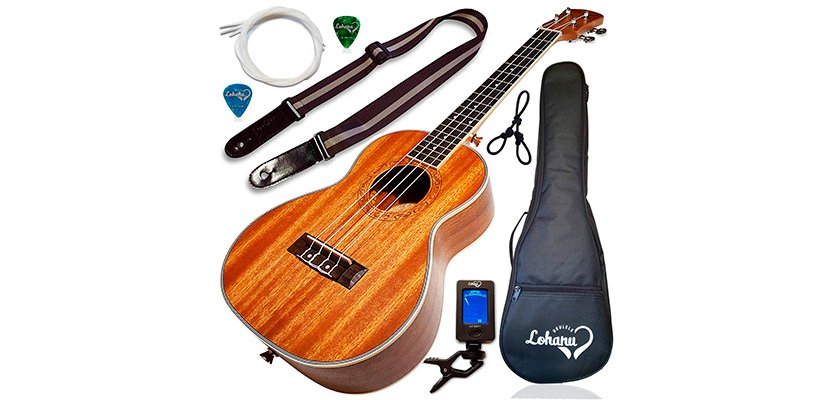
This ukulele is well built and has many thoroughly worked out details like white binding, smooth edges, etc. It’s definitely worth being named the best beginner tenor ukulele on the list, while it yields in the ampleness of sound to the solid wood models.
The ukulele is guitar-shaped and looks classic, with a stylish yet non-flashy look. Black fretboard and bridge are lined with the white saddle and nut. The neck and body bindings are white and smooth, without sharp edges. The head features a laser-carved “Lohanu” trademark, and the rosette has a blue ornament around. The uke is made of sapele wood, also known as “African mahogany” and preserving many of the mahogany properties.
The nut and saddle aren’t high ensuring the good string action. The strings are easy to press and hold, and there’s no buzzing or friction during the play. The Lohanu uke has the Nylgut Aquila strings installed “out of the box”; so there’s no need to restring the instrument to get an ample and clean sound.
The instrument produces very clear sound and has a relatively long sustain. Each string, when tuned properly, sounds precise and well-pitched, without shrills. They also have a good reserve of loudness, so you can choose the level at which to play. This uke aims strongly for the position of the best tenor ukulele, while the experienced musicians might like to have an upgraded model soon.
Pros
- Back is arched providing long sustain and warm sound.
- Chrome pegs are sturdy and set the strings precisely.
- Pre-installed buttons for quick strapping.
Cons
- Resonance decreases when playing on higher frets.
- Strings get out of tune quickly.
Video Lohanu LU-T Bundle
Ranch UK-26
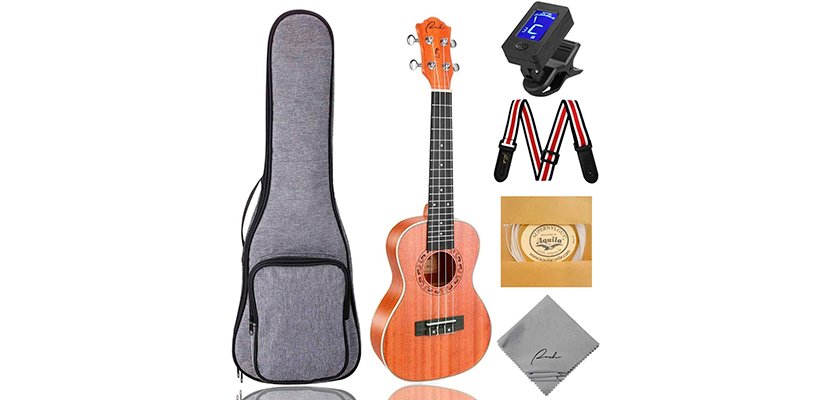
If you have some experience with string instruments and eager to learn ukulele, this affordable tenor ukulele kit is a solid option to consider. It has a strap for comfortable stand up playing, a bag, a digital tuner, and a wiping cloth.
The ukulele is made of different wood types and makes a deep well-balanced sound. The top and back of this uke are made of sapele, while the bridge, neck, fretboard, and head are cut from rosewood. The fretboard is worked out accurately, with nickel frets being thoroughly finished and feeling smooth on the fingers. The backside has arched shape enabling smooth sound movement within the instrument and long sustain.
The ukulele has the Aquila pre-installed strings that do require a bit of tuning, especially during the “break-in” period. The tune pegs are metal and covered with chrome, and have a good level of stiffness to hold the strings in place and be managed easily enough.
The strings are tuned in the re-entrant mode and produce a resonant and clear sound. The tone is warm and spacious while the overall performance is bright and exact. The uke features a solid deep bass and high-pitched highs, accurate and confident mids. Sound-wise, it’s one of the best tenor ukuleles of semi-professional grade.
The design of this ukulele is classic, with the mahogany body and head, and contrast black fretboard. Wide white binding makes the contours smooth and matches the nut and saddle.
Pros
- The strings stay well-tuned all the way along the fretboard.
- Grainy expensive-looking finish.
- Fabric carrying bag with handles is nice to touch and feels reliable.
Cons
- The body is a bit too lightweight in comparison to the headstock and the neck.
- The supplied strap feels sharp on the shoulder.
Paisen
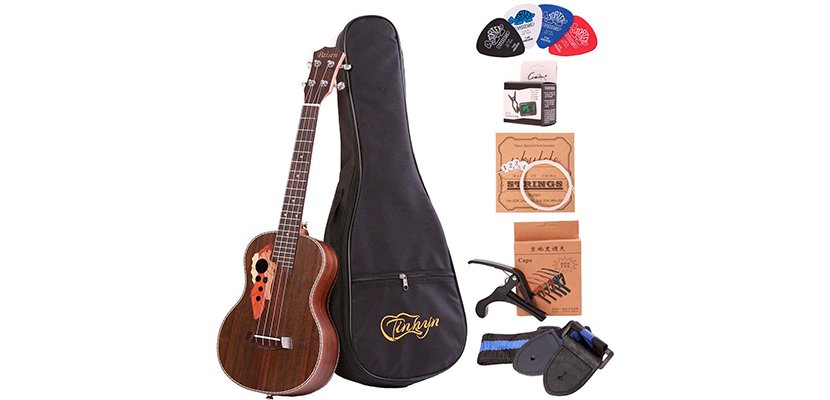
This rosewood tenor ukulele has an exquisite design and high-quality assembly. It can be used as a professional instrument for rehearsal, music writing, or gig performance. Meanwhile, its solid build and a full set of accessories make it a good option for beginner musicians as well.
All parts of this uke instrument are made of rosewood, with different tint for body and fretboard / neck parts. The finish is grainy and feels warm and satin-like; the ukulele doesn’t slip in the hands. The fretboard is cut in grades at the bottom, while the sound holes are located not in the middle part of the body but right to the strings. There are six holes in total, four smaller ones aligned in the T-shape.
The backside of the instrument is curved to produce good resonance and richness of sound. The strings are nylon and connected firmly to the enclosed tuning pegs. The latter are made of solid metal and operated with ease.
The uke comes with accessories kit including picks, a digital tuner, an over-shoulder strap, a gig bag, and a capo for the strings. There are also video lessons for beginners to start playing right away.
The sound produced by this ukulele tenor has good volume and sensitivity. The bass has good weight and volume, while the mids are strong, a bit into the warmth. Highs are open and bright, with a lot of clarity and character. The overall sound is harmonic and exact.
Pros
- Exquisite striped binding is smooth and looks stylish.
- Low action makes it easy to play and adds depth to the sound.
- The bag is well-padded from all sides.
Cons
- No fret markers on the side.
- Dubious ornament around the sound holes that affect the sound.
Video Paisen
Hola Music HM – 127SM+
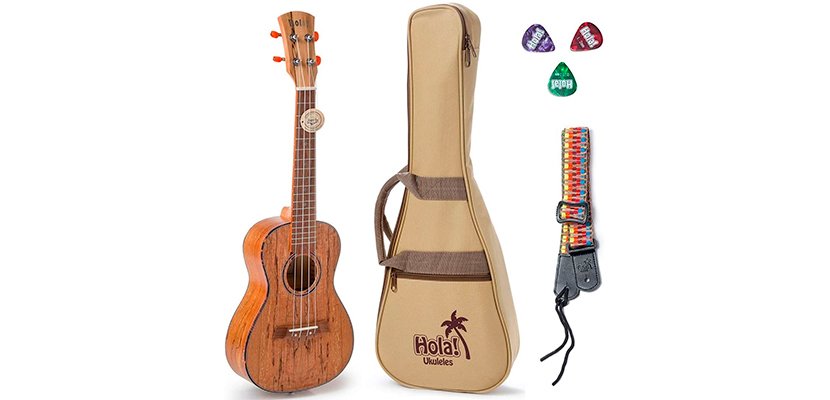
The kit that comes with this tenor ukulele can satisfy both the ukulele newbies and seasoned players. It includes the light canvas bag with a zipper pocket, a multicolored regulated strap, three solid picks, and free uke playing classes (2 months live option).
The body of this ukulele is made of the spalted maple. This wood type is soft and streaked providing the high density of sound at any frequency point. The sound is warm and fluent, with gurgling round bass, clear mids, and precise pitched highs. The tonality is warm and rich, and the volume range is vast enabling the player to produce both quiet and very loud sounds.
The body of the uke and the rosette bound with the mahogany-colored celluloid, and the fretboard is aligned with the thin stripe as well. The binding accentuates the ukulele shape and protects the player’s fingers from bumping on frets ends.
The fretboard is made of expensive rosewood and has fancy clover marks for fret indicators. The nylon Aquila strings complement the high-quality woods and produce a sustained developing sound. The bridge is made of walnut and features a compensated saddle allowing the player to fine-tune the ukulele exactly to the player’s individual preference.
The Nato neck is sturdy and has a smooth grainy finish. It sits in the palm confidently. The headstock of this ukulele tenor features the sturdy tuning knobs with the non-slippery celluloid pegs making it easy to tune up the uke whenever it is needed.
Pros
- Ox bone nut supports a dynamic resonant response of the strings.
- All parts are coated with a thin layer of lacquer making the finish smooth.
- Consistent intonation throughout the fretboard.
Cons
- Nut edges are sharp at the sides.
- Fret ends aren’t smooth.
Balnna UL-26C
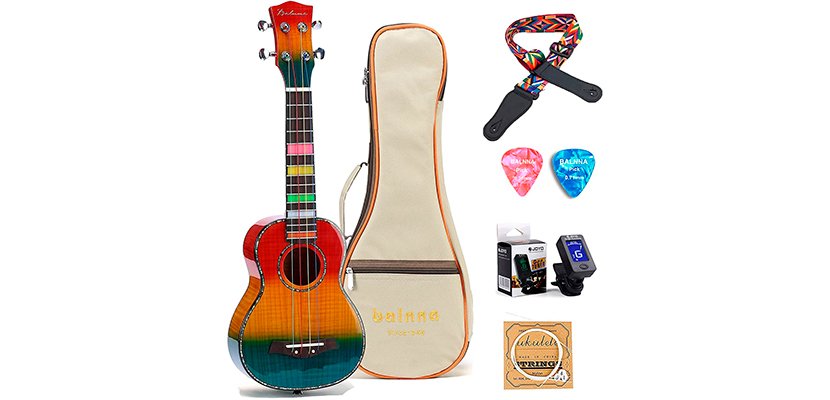
This uke definitely stands out of the row of classic ukulele tenors, both for its looks and performance. It’s well-built and is easy to master thanks to its ample color-coding. It provides a lot of comfort while playing, both for the beginner and the experienced uke player.
The body is made of tiger maple, painted in the rainbow color. This type of maple wood is one of the high-value ones. With the striped grainy surface, it has a unique texture and impact on the sound. It amplifies and provides a lot of resonance making the sound developing and enriching. The motley binding of the body and rosette makes the instrument look flashy and feel smooth at the edges. The player’s hands and fingers glide over the binding easily.
The fretboard and bridge are made of rosewood to provide depth and soft vibration to the sound. Frets are color-coded with inlaid colorful insertions letting find the needed fret within a fraction of a second. As many premium ukuleles tenor type, the Balnna UL-26C is equipped with the Aquila strings that bring a balanced clean sound.
The sound of this colorful uke is dynamic and precise. It provides a good tone both in strumming and melodic performance. Bass and mids have good separation and provide a lot of punch. Highs are bright, with a distinctive pitch.
Pros
- Strings are painted in different colors to simplify the tuning.
- Thin glossy finish, doesn’t smell.
- The bag has two straps to wear it on the back (backpack type).
Cons
- Action is a bit too high on the nut.
- Upper-laid frets are sharp and need filing.
Video Balnna UL-26Cn
Cordoba 15TM
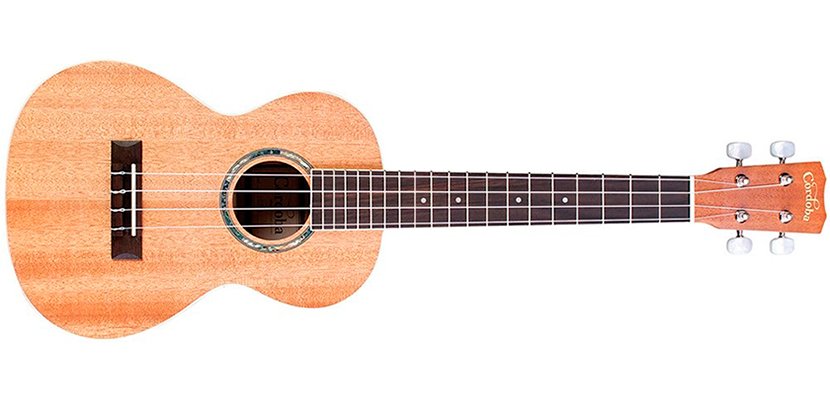
This solidly built Cordoba 15TM tenor ukulele is comfy to hold and easy to play. It has many tiny details, like side markers for frets and textured surface, for comfortable playing. It’s a professional-grade instrument, which also makes a good option for beginner musicians.
The uke body is made of high-quality mahogany providing a solid base for a full sound with the long sustain. The neck is made of the same material colored in creamy tones, with the black fingerboard featuring the satin finish. The latter provides easy movement of fingers on the frets, while not being slippery. The duplicate black markers on the neck side simplify the complex performance allowing you to find the needed fret at a glance.
The body and fingerboard have solid white binding bringing both smooth contours and accentuated the shape of the ukulele. The rosette is adorned with the abalone-colored narrow strip making the only color contrast in the instrument design.
The tuners on this tenor ukulele with pickup are sturdy and sensitive that let control the string thoroughly. There are pearl buttons holding the strings in, and the string tension is handled by the silver tuning pegs. The action is middle-type on this uke providing a good base for strumming and staccato-like performance. Meanwhile, the rich bass and colorful mids emitted by the instrument benefit the complex melodic composition as well.
Pros
- The neck is long enough to hold 19 (not narrow) frets.
- The nut has a good width (1½-inch) for both small and big fingers.
- Warm tonality and distinct clear sound.
Cons
- Frets are somewhat sharp on ends.
- The fingerboard ends squarely next to the sound hole, no cutout or rounding edge.
Enya EUT-X1
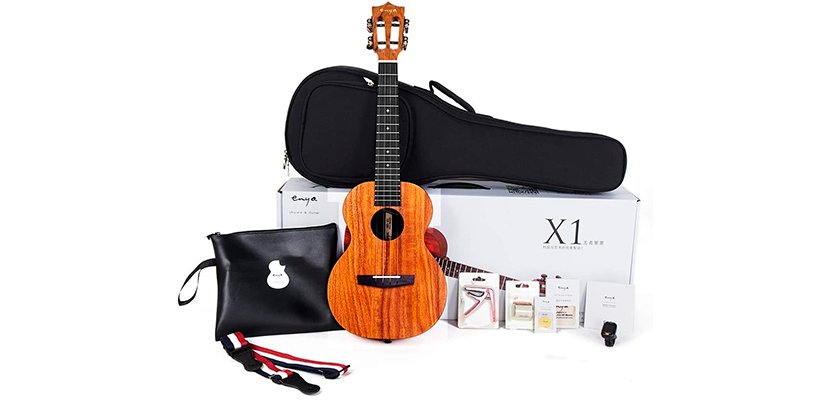
The composite material used in the build of this Enya tenor ukulele makes it look close to the natural ones. Besides, it’s highly durable and time-proof construction, it doesn’t change the tone or sound depth over time. It can be played in any temperature and humidity, and preserves the tuning mode. Once tuned, this ukulele keeps the string tension for long.
The top, side, and back parts of this uke are made of HPL, which is known for its resistance to elements and wearing. The uke body has good resonance, though it does sound flatter than with high-quality wooden models. The neck is made of mahogany and laid with the black richlite fretboard. The latter is easy to play on, with white diamonds marking certain frets.
The headstock on this ukulele is the slotted guitar-type, with open tuners. The pegs are glossy and have slight recess enabling good finger hold and sensitivity. The installed strings are D’Addario made, have good tension and sustain.
The Enya HPL Koa tenor ukulele produces soft sound with good depth. The highs are a bit rounded at the extreme treble, while the overall sound is well-balanced and the tonality is mellow. Bass is solid, with nice reverb at strumming, and mids have good clarity and accentuation.
The ukulele comes with a full kit to carry it along and maintain. There’s a carrying bag, a capo, replacing strings, a shoulder strap, picks, a sand shaker, and a polishing cloth in a set.
Pros
- The BT style of neck mounting allows adjusting the string action with the neck repositioning.
- Radiused fretboard lets play barre chords with ease.
- Solid padded gig bag with a separate pocket and two straps.
Cons
- Restringing takes time and effort due to the opened headstock type.
- No binding / rosette ornament.
Caramel
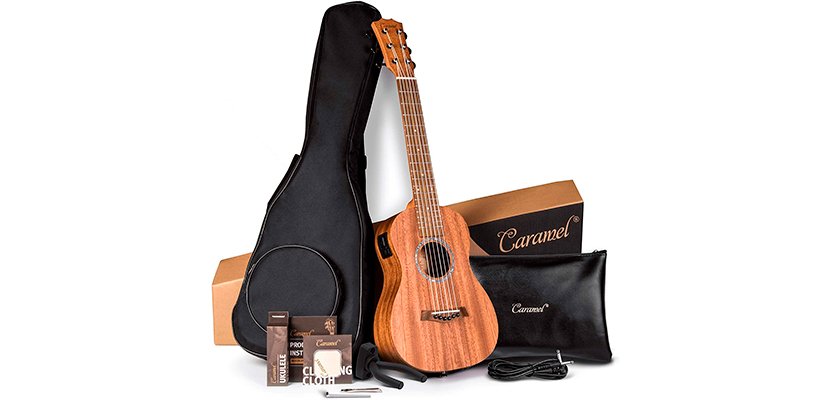
This uke differs from the majority of ukulele tenors on the list for its type, build, sound, and available options. Featuring six strings, it makes a guitalele with E-A-D-G-B-E tuning mode. It can be used for playing complex guitar composition and general ukulele songs. It can serve as a fully functional guitar replacement for travel, rehearsal, small gig, etc.
All parts of this guitalele are made of solid mahogany wood providing a resonant deep sound with a long sustain and distinct notes separation. Highs are airy and clean, the bass is rocky and solid, and mids feature good depth and clarity. The sound is sharp when strumming and soft at fluent play.
The neck of this 30-inch ukulele is quite long holding 18 frets with 6 white dots for markers (duplicated on the side of the neck). Fingerboard and bridge are made of walnut and support the strings reliably while the grainy surface provides a good base for fixing the string with the fingers. The tuning mechanism is metal with copper and open string posts. The neck can also be adjusted through the Truss Rod making the action higher or lower with regard to player’s preference.
Another distinctive feature of this guitalele is the ability to be amplified and serve as an electric instrument. The Caramel acoustic electric tenor ukulele has a built-in mic, the EQ cable jack, and can be hooked up to an amp or recording gear.
Pros
- Color LCD display and EQ / Volume knobs let set up the performance in accordance with the player needs.
- The nut and saddle are made of bone and provide for long natural sustain.
- Bound fretboard with non-sharp frets.
Cons
- No finish on fretboard.
- No pre-installed strap pegs.
Kala KA-15T
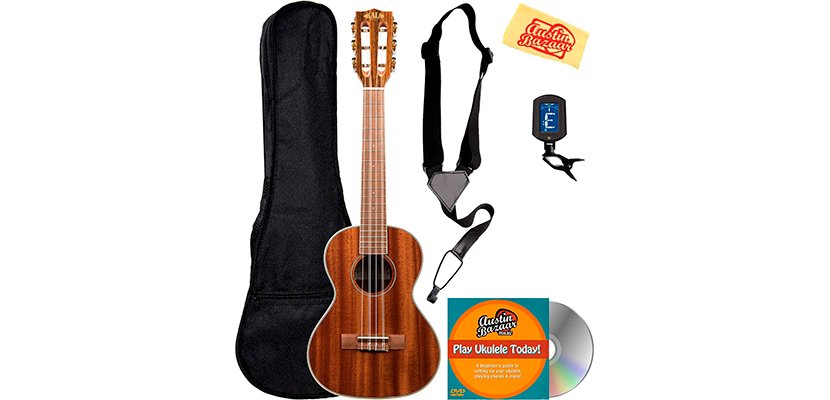
Produced by the brand well-known for their ukuleles tenor instruments, this 6-string guitalele features high-quality build and assembly. It comes with a whole bundle of useful things like a gig bag, a polishing cloth, uke classes DVD, a shoulder strap, and a digital tuner while its cost also exceeds many of its competitors at least twice.
The guitalele main parts are made of mahogany, which is finely cut and worked out. The finish is closer to a rural type than to glossy while being smooth yet non-slippery to touch. It’s easy to hold the ukulele and manage the strings on the fretboard, without the risk of missing out the fret or let go of the instrument.
The fingerboard and bridge are walnut, providing mellow contrast with the ukulele body. The fretboard runs up to the sound hole partly covering the minimalist rosette. The latter has two white stripes aligned precisely around the sound hole. The fretboard and the body are bound with the same expensive-looking white-striped binding that highlights the instrument shape and makes the edges smooth.
The strings installed on this Kala ukulele tenor are the high-quality Aquila strings. They sit precisely on the NuBone nut and are tuned by the chrome-plated metal tuners. The latter sit in the open-type headstock of the guitalele, with the pearl pegs, turned backside. Tuning might seem a bit tricky in comparison to the closed-type systems; meanwhile, the tuners are responsive and adjust the string to the optimal tension required.
Pros
- Rich spacious sound with a lot of resonance.
- Distinct side fret marking (black dots on white binding).
- Well-leveled frets provide consistent sound throughout the fingerboard.
Cons
- Plastic collars, around the pegs, don’t stick to the headstock and might rattle during the play.
- Action is a bit high; can be difficult for beginner players.
Luna Tattoo TTN MAH
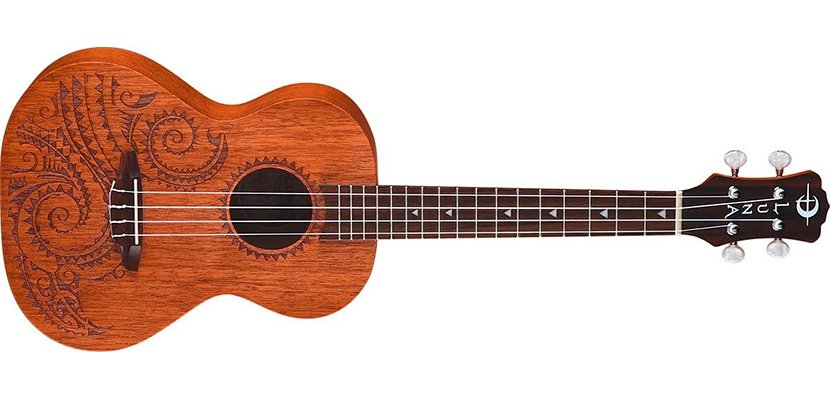
This middle-class tenor uke features a sound build, original Hawaiian design, and matching sound. It comes with a gig bag to carry it along and store, which makes it a worthy option both for professional ukulele players and for beginners who don’t mind shelling out more for a quality instrument (the cost is about twice as high as the majority of competitor ukes).
The ukulele has the all-mahogany construction, except for the walnut fretboard and bridge. It features a satin finish all over the instrument providing a nice smooth touch. The finish layer isn’t thick disclosing a grainy texture that provides good support for fingers and the palms.
The top side of the uke has the Hawaiian ornaments painted in blue color and reminding of a tattoo (hence the name of the model). The ornaments bear the tribal symbols and depict Hawaiian flora and fauna. The main theme is a turtle symbolizing endurance and long life.
The rosette is neatly laid with the sun ornament, and the fret markers on the fingerboard are triangle to remind of the shark teeth. The markers begin with the first fret and also accentuate the 3rd, 5th, 7th, 10th, and 12th ones.
The fingerboard shares its deep dark color with the headstock and is separated from it with the sturdy nut. The head is decorated with the laser-etched Luna logo and features the open-type tuning machine. The pearl tuning pegs on this uke tenor are solid and feel good against the fingers.
Pros
- Even frets with smooth ends.
- Spot-on intonation throughout the fretboard.
- The good setting of strings, wide enough for large fingers.
Cons
- Tuner pegs have a little play.
- Features a bit of muddiness at chords’ playing.
Kulana GUKT
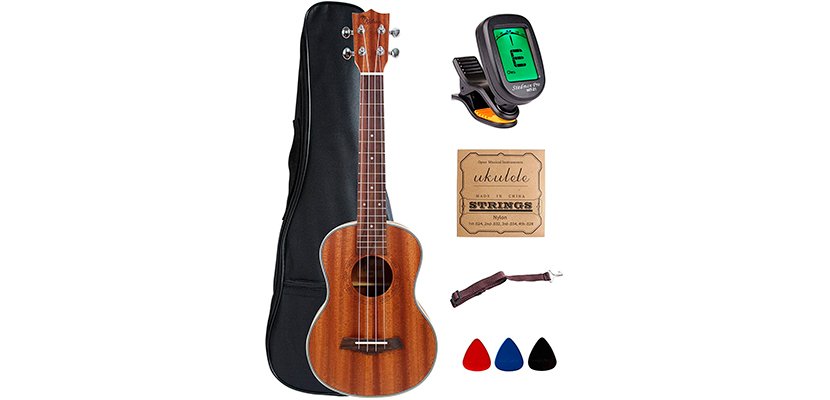
This instrument has multiple features of the premium tenor ukuleles while costing like a modest entry-level model. It comes with a starting kit including the canvas bag, digital tuner, shoulder strap, assortment of multi-colored picks, and the replacement nylon strings.
The ukulele is built of mahogany and rosewood, and features good assembly quality. The seams are even, the finish is smooth, and the tiny parts are fitted reliably. The top and back part, as well as the sides, are made of mahogany and join the nato neck. The latter is covered with the hard rosewood fretboard with even and well-leveled frets. There are 19 frets in total, with 6 white dot markers visually dividing the fret spaces. The ukulele body has solid white ABS stripes binding the edges. The standard round-shaped sound hole is decorated with the crab ornament rosette.
The head of the uke features all-metal tuners with open tensioning posts. The tuning pegs are chrome-covered and responsive enough to tension the strings precisely. The instrument has the Nylgut Aquila strings pre-installed that sound mellow, with good sustain and loudness.
The sound produced by this cheap tenor ukulele features a lot of “twang” and dynamics. While the overall tonality tends to the warmer side, the highs are well-pitched and open. The mids are accentuated and rich in detail, while the bass might seem a bit too rounded.
Pros
- The tuners hold the tension well even during the “break-in” period.
- Good resonant sound at different playing techniques.
- The solid wood bridge looks authentic and brings warmth to the uke tone.
Cons
- Frets polish is insufficient, sharp ends.
- The nut can be slightly bending at hard strums creating the buzz.
Buyer’s Guide
How to Choose the Best Tonewoods for Your Tenor Ukulele?
The detailed ukulele description necessarily features the material it’s made of, and the particular tonewood used. That’s important, as the tonewoods differ by several parameters, each affecting the way the instrument reacts to the sound:
- Thickness (weight). The heavier the wood, the richer sound it will reproduce. Heavy woods are maple, spruce, walnut. Meanwhile, the light tonewood brings bright upper notes and overall resonance. These are cedar, mahogany, alder, etc.
- Density. Wood density influences the tonality, pitch, sound volume. Dense woods are ash, maple, while the spruce and cedar feature middle density.
- Grainy pattern. The more exquisite patterns and grain the tonewood has, the more nuance is in the sound it produces. Alder, koa, maple have a lot of grain texture, while the basswood, mahogany, and spruce feature less grain.
Let’s have a look at the most popular tonewoods used for the tenor ukulele size instruments.
Mahogany
The ukulele instruments are often made of mahogany. This relatively thick but not too dense tonewood provides a lot of resonance, which is favorable in the ukulele. It provides bright open highs, while the accent is on the mids that are full and clean.
Mahogany is often used for solid wood ukes bringing a warm emphasis into the sound. The tonality is mellow, and the overall sound is fluent, while the grainy structure of mahogany wood favors the “twangy” style of playing as well. Strumming on the mahogany ukulele, you get a whole bunch of nuance blending into the bright ringing sound.
The popularity of mahogany as a ukulele tonewood is also caused by its inner structure rich for patterns and color shades. This tonewood is cheaper than rosewood and is often used in the budget ukulele instruments for neck parts.
Koa
Koa is considered the “authentic” ukulele tonewood and is valued as such. Besides, the Koa tree grows only in Hawaii so that its cost rises even more due to its rarity.
Koa is relatively light and isn’t dense making an ideal solution for the lightweight and small ukulele. Koa is often used for the whole uke body and parts. Its variety of colors and patterns makes it an attractive design solution, while the sound it emits gets very resonant, warm, and full. The Koa sound is well balanced, with the warm and clean tonality and increased brightness. If you’re looking for the best sounding tenor ukulele, get the uke made of Koa.
Nato
Nato wood is often used for ukulele parts, especially necks. It’s similar to mahogany in many properties (and even called the “eastern mahogany”) but is more economic. The tonewood also has a lot of grain in its structure and various patterns bringing a certain accent to the sound.
The Nato produced sound features punchy dynamics and isn’t as warm as a mahogany sound signature. Meanwhile, it has a tight tone and provides well-accentuated highs. The Nato is softwood while enduring the humid climate well. This makes the Nato made ukuleles highly durable.
Laminate or Solid Wood
When it goes about the ukulele tonewoods, it’s important to stress what kind of wood material is used, solid wood, or laminate. The former is cut out of the piece of intact wood, while the laminate means the several sheets of the wood are fused together to form a “wood” piece.
Solid wood instruments are more authentic, however, there are several factors making the laminate wood attractive for uke players and manufacturers.
Advantages of using the laminate wood in the ukulele construction:
- Cost. Laminates are way less expensive than solid woods, both for the manufacturing process and finishing works. The solid wood requires thorough polishing, while the laminate surface is usually smooth.
- Weatherproof. Laminated ukes don’t soak the humidity or get dried up as fast as solid wood models. This makes them a good option in highly humid areas or regions with extreme temperatures.
- Less maintenance. Laminated ukuleles don’t require strict storage conditions or maintenance. They can be forgotten in the rain or put next to the heating, without a noticeable impact on the sound.
Solid wood ukes also have their pros:
- They’re more flexible, allowing more resonance and openness to the sound. The solid wood body provides more vibration and sustains responding to the sound wave, than the laminate one.
- The cutout solid wood preserves general tonal qualities of tonewood, while laminates usually lose some of the initial tone.
- These ukuleles change the way they sound with time acquiring more sustain, character, and tonal warmth.

Hi everyone! I’m Thomas Moody, also known as Guitarzan.
